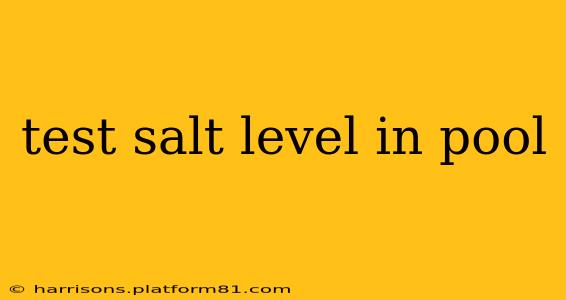Maintaining the perfect balance of salt in your saltwater pool is crucial for its cleanliness, the longevity of your equipment, and overall enjoyment. Too little salt, and your chlorine generator won't work efficiently. Too much, and you risk damaging your pool's finish and equipment. Knowing how to accurately test your pool's salt level is, therefore, essential. This guide will walk you through the process, answering common questions along the way.
What is the ideal salt level for a saltwater pool?
The ideal salt level for a saltwater pool typically ranges from 2,700 to 3,400 ppm (parts per million). However, always consult your specific pool equipment's manufacturer's instructions, as this range can slightly vary depending on the model and type of chlorine generator you have. Maintaining this level ensures optimal chlorine generation and prevents issues.
How often should I test my pool's salt level?
Regular testing is key to maintaining the perfect balance. Aim to test your pool's salt level at least once a month, or more frequently if you experience significant water loss (due to backwashing, evaporation, or rain). More frequent testing is also recommended during periods of high use or extreme weather conditions.
What equipment do I need to test my pool's salt level?
You'll need a saltwater pool test kit. These kits are readily available at most pool supply stores and online retailers. There are several types, including:
- Test strips: These are convenient and affordable, offering a quick, albeit less precise, reading.
- Digital salt meters: These provide more accurate and precise readings compared to test strips. They are generally a worthwhile investment for consistent monitoring.
- Test kits with reagent tablets or liquids: These offer a more precise measurement than test strips, providing a broader range for analysis.
Choose a kit that fits your budget and desired level of accuracy. Always follow the manufacturer's instructions meticulously for accurate results.
How do I use a saltwater pool test kit?
The exact process varies depending on the type of test kit you're using. However, here's a general overview:
- Collect a water sample: Gather a water sample from your pool, ensuring it's taken from at least 12 inches below the surface and away from any jets or returns. Avoid collecting water near the pool's walls or steps.
- Follow the kit's instructions: Each kit will have specific instructions. Carefully read and follow them. This usually involves adding a reagent to the sample, waiting for a reaction, and comparing the color or reading to the kit's chart or digital display.
- Record your results: Note down your salt level reading for future reference and tracking.
What if my salt level is too low?
If your salt level is too low, your chlorine generator won't produce enough chlorine to sanitize your pool effectively. You'll need to add more salt to your pool. The amount you need to add will depend on the size of your pool and how far your salt level is below the ideal range. Use a pool salt calculator (easily found online) to determine the precise amount needed. Always add the salt slowly and evenly, ensuring it dissolves completely to avoid clumping.
What if my salt level is too high?
A salt level that's too high can damage your pool equipment and potentially corrode your pool's finish. If your salt level is too high, you'll need to dilute the water. This can be achieved by draining a portion of the pool water and refilling it with fresh water. Again, consult a pool professional or use online calculators to determine the appropriate amount of water to drain and refill to reach the ideal salt level.
How do I know if my salt level is affecting my chlorine generator?
A malfunctioning chlorine generator is often a symptom of an incorrect salt level. If you notice your chlorine levels are low despite regular additions, or if your generator is constantly running, this could be a sign of insufficient salt. Conversely, a consistently high chlorine level despite normal salt readings could indicate the generator is overworking due to excess salt. In either case, testing your salt level is the first crucial step in troubleshooting.
Remember, regular testing and maintenance are vital for keeping your saltwater pool clean, safe, and enjoyable. If you're unsure about any aspect of testing or maintaining your pool's salt level, consult a qualified pool professional for assistance. They can provide personalized advice and ensure your pool remains healthy and sparkling.
